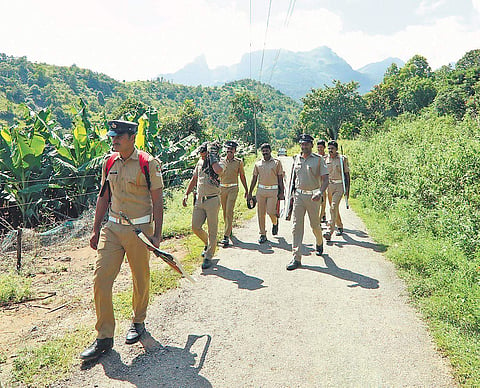

KOCHI/KOZHIKODE: our Maoists may be down, but there are more to go, including a dreaded arms-trainer who escaped from the encounter site at Manjakandi in Palakkad on October 28. Hence, the state has decided to intensify its anti-Maoist operation to hunt down the high-value target-- Deepak of Dandakaranya Special Zonal Committee (DKSZC).
Deepak reportedly fled the site before Thunderbolt could zero in on him. Central intelligence officers said Deepak, one of the most wanted Maoist leaders, has been providing training in arms and Improvised Explosive Devices (IEDs) to Maoist cadre across the country. “Two persons fled the scene when the exchange of fire took place. Deepak is a prime asset of the CPI(Maoist) and the outfit will go to any extent to protect him,” said a senior officer.
DKSZC is based in Chhattisgarh from where all senior leaders of CPI (Maoists) operate and coordinate the activities with Dalams (squads) spread across the country. “It’s the DKSZC that controls and operates the training centres and arms-making units in Chhattisgarh. As per intelligence inputs, Deepak has been specifically assigned to train cadre operating from Kerala-Tamil Nadu-Karnataka (KTK) in arms and IED- making.”
North Range Inspector General Ashok Yadav also confirmed that two persons escaped from Manjakandi following the encounter. “One is suspected to be a prominent leader of the outfit from Chhattisgarh or Jharkand who is an expert in arms training,” he said. The cadres of different Dalams have started to work and move together which is a new trend in the outfit. A Wikileaks document says that Dandakaranya Special Zonal Committee (DKSZC) is led by high –profile Maoists who are also on the Central Committee and many of them were previously in the North Telengana Special Zonal Committee.
Officers said the presence of high-profile leaders in KTK reveals that the Maoist cadres had been shifting base from states like Andhra Pradesh and Telangana to KTK.
The activities of left-wing extremists lost steam in Andhra Pradesh after the crackdown launched by the state’s elite Greyhound anti-Naxal force. The Maoists suffered heavy losses after 2007 and many of their operating centres had to be closed down pushing the cadre to other operational destinations.
Dhinesh Kallungal @ T’Puram
After a sizeable gap, the gunning down of four Maoists by the state police at Attappadi in Palakkad recently, has yet again put the spotlight on the Naxal movement or Maoist groupings in the state. And they have grabbed headlines due to a variety of reasons.
A latter-day version of Naxalism borne out of Mao’s political philosophy
Naxalites and Maoists: Are they the same?
Well, both are inspired and guided by the political thoughts of Mao Zedong. If the armed peasant uprising in West Bengal’s Naxalbari village paved the way for Naxal movement in Kerala, it was more of an intellectual phenomenon rather than political activism. ‘Maoism’ was coined by the media to refer to the armed revolutionaries of Naxal movements, say former Naxal veterans. Even among the cadre, the term ‘Maoism’ is seldom if ever used in communication. Instead, Communist Party of India (Marxist Leninist) is used. Though, both are same and fight for the downtrodden, there is a subtle difference in their modus operandi. If Naxals stood for mass movement through armed rebellion, Maoists bank on armed movement to achieve their professed aim. K Ajitha, former Naxalite from the state, said despite the difference in their names, both champion the cause of the poor.
If the ideology has few takers, why are they still out there in the wild?
Several former Naxals, whom Express spoke to, refused to comment on this. However, a few, on condition of anonymity, said around 70 % of the Maoist leaders had deserted the movement in the last five years due to various reasons. While a good number of them had been gunned down in various encounters, many chose to surrender before the police. “The other thing is that we cannot desert the aged comrades, who spent well almost all their lives fighting for the movement, at the half-way stage. It is also very risky to protect them. We believe several of these ‘encounters’ are the fallout of negotiations which fell through. The police also use the occasion to target the cadre unilaterally,” they say.
So-called Maoists’ influence on tribals in Kerala?
The fact is though Maoists have considerable influence among the downtrodden and tribals in poorly developed areas of states like Jharkhand, Odisha, Chhattisgarh and Andhra Pradesh, their impact on tribals in Kerala is next to nothing. Philip M Prasad, a former Naxal, says Maoists have little influence among tribals in Kerala. According to him, even at their peak, the ultras failed to impact even 1% of the tribal population in Kerala. Naxal movement in Kerala was an intellectual leadership activism. It is true that Naxals had worked among the tribals and the poor, but they failed to create ripples in the public order or a mass movement. And this is one of the reasons for the movement fading into 0bscurity in Kerala.
What is the movement’s future in highly politicised Kerala?
Maoist activities in Kerala are confined to distributing leaflets and sticking posters in far-flung Adivasi hamlets. There is no potential Maoist movement in the state and there is no scope for it. But outside the state, things are still different where the ideology still finds several takers.